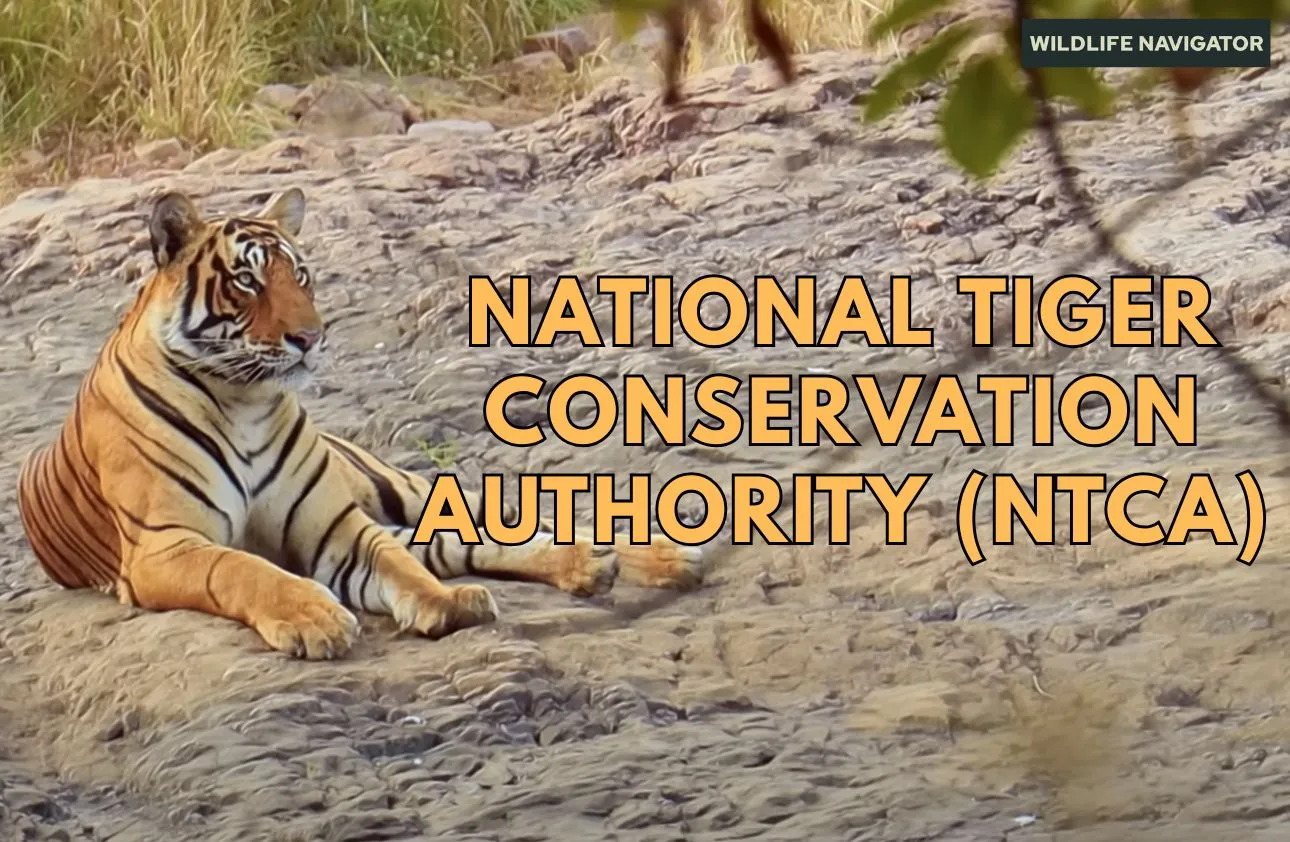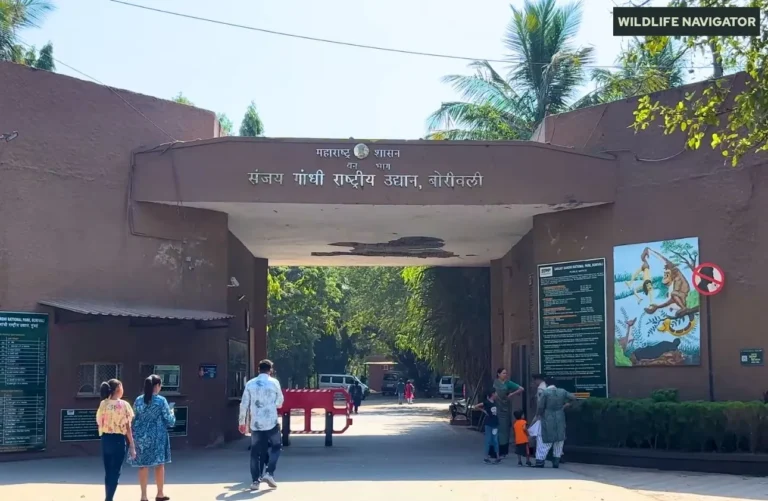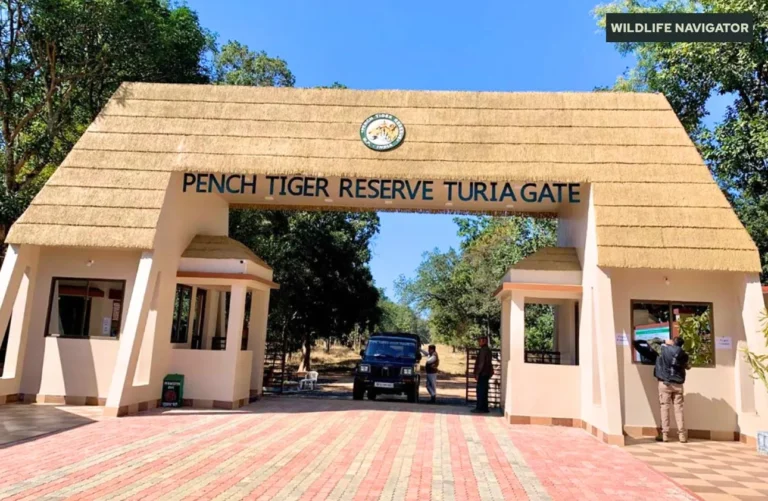National Tiger Conservation Authority (NTCA): India’s Guardian of Tigers and Tiger Reserves

India, home to nearly 75% of the world’s tiger population, stands as a global leader in wildlife conservation. Protecting this majestic predator is not just about saving one species — it’s about preserving entire ecosystems that sustain countless forms of life. To ensure the long-term survival of tigers and their habitats, the Government of India established the National Tiger Conservation Authority (NTCA) — the apex body responsible for overseeing and strengthening tiger protection efforts across the country.
The NTCA operates under the Ministry of Environment, Forest and Climate Change (MoEFCC) and plays a pivotal role in implementing Project Tiger, one of the most successful wildlife initiatives in the world. It sets standards, provides financial assistance, monitors reserves, and ensures that tiger conservation aligns with both ecological and community interests.
1. Why NTCA Matters
- Ensures scientific management of tiger reserves
- Promotes coordination between the central and state governments
- Strengthens laws against poaching and habitat destruction
- Balances conservation with local livelihoods through eco-development
The NTCA isn’t just an administrative body — it’s the guardian of India’s wild heart. Its work ensures that future generations can continue to witness the silent grace and raw power of tigers roaming freely through India’s forests.
2. History and Establishment of NTCA
The story of the National Tiger Conservation Authority (NTCA) begins with India’s growing realisation that the tiger — once abundant across its forests — was in grave danger. By the early 1970s, rampant poaching, shrinking habitats, and human pressures had pushed tigers toward extinction. This crisis led to one of India’s most significant wildlife missions: Project Tiger, launched in 1973.
2.1 From Project Tiger to NTCA
While Project Tiger made remarkable progress, the need for a statutory body to strengthen its legal and administrative foundation became clear. Thus, the National Tiger Conservation Authority was established in 2005, following the amendment of the Wildlife (Protection) Act, 1972.
NTCA was formed to:
- Provide a legal framework for tiger conservation
- Ensure accountability and transparency in management
- Strengthen anti-poaching and habitat protection measures
- Coordinate effectively between the Centre and State Governments
2.2 Key Milestones in NTCA’s Journey
- 1973 – Launch of Project Tiger with nine reserves
- 2005 – NTCA officially established as the apex body
- 2006 – Tiger Task Force report leads to major reforms
- 2010–Present – Use of modern technology like camera traps, GIS, and M-STrIPES for monitoring
- 2022 – India records over 3,000 tigers, showcasing NTCA’s success
Today, NTCA stands as a symbol of India’s commitment to wildlife preservation — a model admired and replicated by many nations.
3. Structure and Organisation of NTCA
The National Tiger Conservation Authority (NTCA) is a well-structured body designed to ensure strong coordination and efficient implementation of tiger conservation programs across India. It functions as an autonomous statutory authority under the Ministry of Environment, Forest and Climate Change (MoEFCC).
3.1 Headquarters and Administrative Setup
- Headquarters: New Delhi, India
- Regional Offices: Located in major tiger landscapes such as Central, Eastern, Western, and Southern India
- Jurisdiction: Covers all tiger reserves notified under the Wildlife (Protection) Act, 1972
The NTCA’s organisational structure ensures a direct connection between central policies and ground-level implementation in each reserve.
3.2 Composition of NTCA
NTCA consists of a balanced mix of officials, experts, and representatives to ensure scientific, administrative, and community-oriented decision-making.
Key Members Include:
- Chairperson: Minister of Environment, Forest and Climate Change
- Vice-Chairperson: Minister of State for Environment and Forests
- Member Secretary: An officer of the Indian Forest Service (IFS), responsible for daily administration
- Official Members: Senior officers from MoEFCC, Finance, Tribal Affairs, and Rural Development Ministries
- Non-Official Members: Experts in ecology, wildlife, conservation, and representatives from tribal communities
3.3 Coordination with Field Authorities
NTCA works closely with:
- Field Directors and Chief Wildlife Wardens of tiger reserves
- State Forest Departments for funding, management, and protection
- Scientific institutions like the Wildlife Institute of India (WII)
- Non-Governmental Organisations (NGOs) for awareness and community participation
This structured setup ensures that policies made at the national level reach the forest floor, where real conservation happens — protecting both tigers and the communities that share their landscapes.
4. Objectives and Functions of NTCA
The National Tiger Conservation Authority (NTCA) was established with a clear vision — to ensure the survival, protection, and growth of tigers in India through scientific management, policy guidance, and community participation. Its objectives go beyond saving a single species; they aim to preserve the entire ecosystem that sustains India’s rich biodiversity.
4.1 Primary Objectives of NTCA
- Strengthen Tiger Conservation:
Implement strong measures for the protection and recovery of wild tiger populations across India. - Ensure Scientific Management:
Promote research-based conservation strategies and habitat management plans. - Enhance Coordination:
Facilitate smooth collaboration between central and state governments for effective conservation actions. - Combat Poaching and Illegal Trade:
Support anti-poaching operations, intelligence sharing, and enforcement against wildlife crimes. - Promote Eco-development:
Encourage sustainable livelihood options for local communities living around tiger reserves. - Monitor Population Dynamics:
Use technology like camera traps and the M-STrIPES system to track tiger movements and numbers. - Encourage Responsible Tourism:
Promote eco-tourism models that benefit both wildlife and local people.
4.2 Core Functions of NTCA
Under the Wildlife (Protection) Amendment Act, 2006, NTCA performs several essential functions:
- Lay down guidelines for tiger reserve management
- Approve annual plans of operation (APOs) from tiger reserves
- Provide financial and technical assistance to states
- Ensure relocation of villages from core tiger habitats when necessary
- Establish norms for eco-tourism and visitor management
- Evaluate and monitor the status of tiger reserves periodically
- Prepare annual reports on the condition of tiger populations and habitats
Through these objectives and functions, the NTCA acts as the guardian framework that unites conservation policy, science, and community welfare — ensuring that tiger conservation in India remains effective, inclusive, and future-ready.
5. NTCA and Project Tiger
To understand the National Tiger Conservation Authority (NTCA), one must first understand Project Tiger — India’s most iconic and successful wildlife conservation program. Launched in 1973, Project Tiger aimed to halt the alarming decline of India’s tiger population by creating protected areas exclusively for tigers and their habitats.
However, over time, it became evident that stronger legal backing, better funding mechanisms, and closer coordination were needed to sustain the program’s success. This led to the formation of NTCA in 2005, giving Project Tiger the statutory authority and structure it needed to function effectively across India.
5.1 How NTCA Strengthens Project Tiger
NTCA acts as the regulatory and implementing arm of Project Tiger. It provides:
- Policy Direction – Framing guidelines for reserve management and protection
- Financial Support – Allocating central funds to states for tiger conservation
- Monitoring and Evaluation – Regularly assessing tiger population, prey base, and habitat health
- Technology Integration – Implementing systems like M-STrIPES (Monitoring System for Tigers – Intensive Protection and Ecological Status) and camera trapping
- Community Involvement – Promoting eco-development and alternative livelihoods for forest-dwelling communities
5.2 Major Achievements under NTCA’s Guidance
- Tiger Population Growth: From 1,411 tigers in 2006 to over 3,000 in 2022, showing a remarkable recovery.
- Expansion of Tiger Reserves: From 9 reserves in 1973 to 58 tiger reserves across 18 states.
- Habitat Restoration: Reviving degraded forests, water sources, and prey populations.
- Village Relocation: Ensuring voluntary and ethical relocation from core zones to minimise human-tiger conflict.
- Eco-Tourism Promotion: Creating sustainable tourism models that benefit local people while raising awareness.
Today, NTCA and Project Tiger stand together as the backbone of India’s conservation success story — a model that the world studies and admires. Every roar that echoes through India’s forests is proof of what coordinated conservation can achieve.
6. Tiger Reserves Under NTCA
The National Tiger Conservation Authority (NTCA) is responsible for managing and monitoring all of India’s tiger reserves — the lifelines of Project Tiger. These reserves are protected areas that combine core zones (critical tiger habitats) and buffer zones (regions supporting local livelihoods and eco-development). Together, they form one of the largest networks of protected tiger habitats in the world.
6.1 Growth of Tiger Reserves in India
India started its tiger conservation journey with just 9 tiger reserves in 1973. Today, under the guidance of NTCA, that number has grown to 58 reserves spread across 18 states, covering an area of more than 75,000 square kilometres.
This incredible expansion reflects NTCA’s dedication to preserving tiger habitats across diverse landscapes — from the dense mangroves of the Sundarbans to the dry forests of Ranthambore and the lush jungles of Periyar.
6.2 Regional Distribution of Tiger Reserves
1. Northern India
- Jim Corbett Tiger Reserve, Uttarakhand
- Dudhwa Tiger Reserve, Uttar Pradesh
- Valmiki Tiger Reserve, Bihar
2. Central India
- Kanha Tiger Reserve, Madhya Pradesh
- Bandhavgarh Tiger Reserve, Madhya Pradesh
- Pench Tiger Reserve, Madhya Pradesh / Maharashtra
- Satpura Tiger Reserve, Madhya Pradesh
3. Western India
- Ranthambore Tiger Reserve, Rajasthan
- Sariska Tiger Reserve, Rajasthan
- Melghat Tiger Reserve, Maharashtra
4. Eastern India
- Sundarbans Tiger Reserve, West Bengal
- Similipal Tiger Reserve, Odisha
- Achanakmar Tiger Reserve, Chhattisgarh
5. Southern India
- Bandipur Tiger Reserve, Karnataka
- Periyar Tiger Reserve, Kerala
- Parambikulam Tiger Reserve, Kerala
- Mudumalai Tiger Reserve, Tamil Nadu
- Nagarhole Tiger Reserve, Karnataka
The vast network of NTCA tiger reserves showcases India’s deep commitment to protecting its national animal and ensuring that every region contributes to the national conservation mosaic.
7. Major Achievements and Initiatives of NTCA
Since its formation in 2005, the National Tiger Conservation Authority (NTCA) has played a transformative role in tiger conservation in India. Its work spans from policy formulation to field-level implementation, combining science, technology, and community participation.
7.1 Key Achievements
- Tiger Population Recovery:
- India’s tiger numbers rose from 1,411 in 2006 to over 3,000 in 2022, making India home to the largest tiger population in the world.
- Expansion of Tiger Reserves:
- From 9 reserves in 1973 to 58 reserves today, covering diverse habitats from mangroves to tropical forests.
- Habitat Restoration:
- Initiatives include reforestation, waterhole development, and improving prey availability to support healthy tiger populations.
- Anti-Poaching Success:
- Strengthened enforcement, intelligence sharing, and legal support reduced poaching incidents in many reserves.
- Community Participation:
- Eco-development programs support sustainable livelihoods for forest-dependent communities, minimizing human-tiger conflict.
- Technological Advancements:
- Tools like M-STrIPES, camera traps, GIS mapping, and satellite tracking have improved monitoring and decision-making.
- International Recognition:
- India’s tiger conservation model is celebrated globally, inspiring similar programs in countries like Nepal, Bhutan, and Thailand.
7.2 Major Initiatives
- M-STrIPES (Monitoring System for Tigers – Intensive Protection and Ecological Status): Tracks tiger movements and patrol efficiency.
- Eco-Development Committees: Promote local participation and alternative income sources.
- Tiger Estimation and Research Programs: Periodic scientific surveys to monitor populations and habitats.
- Awareness and Education Campaigns: Schools, communities, and tourists were educated about tiger conservation.
- Policy Reforms: Strengthening wildlife laws and management protocols under the Wildlife Protection Act.
Through these achievements and initiatives, the NTCA has transformed India into a global leader in tiger conservation, showing that science, governance, and community collaboration can save one of the planet’s most iconic species.
8. Conclusion
The National Tiger Conservation Authority (NTCA) stands as the backbone of India’s tiger conservation efforts. From its formation in 2005 to overseeing 58 tiger reserves, NTCA has not only helped increase tiger populations but also preserved critical habitats, strengthened anti-poaching measures, and promoted sustainable community development around forests.
By combining science, policy, technology, and community participation, NTCA ensures that India’s tigers thrive in the wild for generations to come.
Every tiger roar in India’s forests is a testament to NTCA’s dedication — a reminder that conservation is a shared responsibility, where government, scientists, local communities, and wildlife enthusiasts all play a role.
FAQs about NTCA
Q1: What is the full form of NTCA?
National Tiger Conservation Authority.
Q2: When was NTCA established?
NTCA was officially formed in 2005 under the Wildlife (Protection) Act, 1972.
Q3: How many tiger reserves are managed by NTCA?
Currently, NTCA oversees 58 tiger reserves across India.
Q4: What are the main functions of NTCA?
NTCA provides policy guidance, funding, monitoring, anti-poaching support, habitat management, and community-based eco-development initiatives.
Q5: How is NTCA linked to Project Tiger?
NTCA is the apex authority implementing Project Tiger, providing legal, financial, and administrative support to tiger reserves nationwide.





